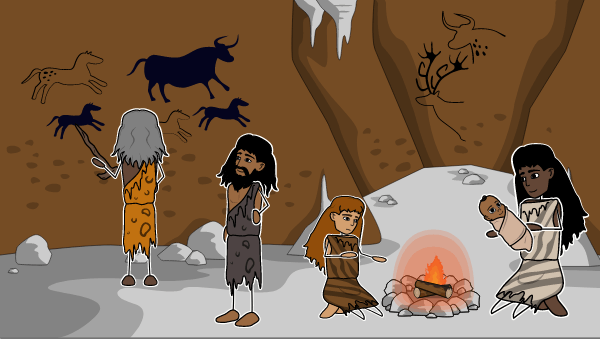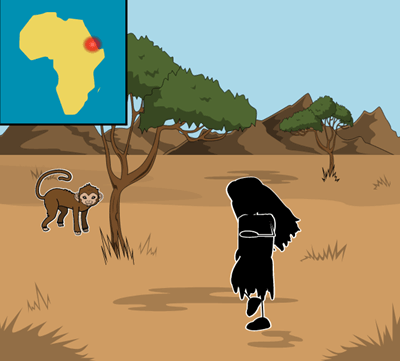

Millions of years ago, our ancestors survived in a very different environment than we have today. They encountered large, terrifying mammals and had to work each day to ensure food and shelter for their survival. The Paleolithic Age saw advances with stone tools while the Neolithic Age brought the discovery of farming and permanent settlements. By investigating the past, we can gain greater insight into our relationship to the earth and each other.








Human beings evolved from a common ancestor over 4 million years ago in Africa. Australopithecines are hominins whose remains were found in Ethiopia. They are believed to be our earliest ancestors. In 1974, “Lucy” (Australopithecus afarensis) was discovered by Donald Johnson at the site of Hadar in Ethiopia. She was estimated to be 3.2 million years old! She was bipedal, meaning she walked on two legs, and was only about 3.5 feet tall. In appearance, she looks more gorilla than human. For twenty years, it was believed that Lucy was the oldest hominid until the discovery of Ardi in 1994 by Yohannes Haile-Selassie. Ardi (Ardipithecus ramidus) was also found in Ethiopia in the Afar desert at a site called Aramis, 46 miles from where Lucy was found. Lucy and Ardi both had small brains and may have lived by taking shelter from predators in trees.
In 1960, Mary Leakey discovered the bones of a hominid that appeared to be a toolmaker. Homo habilis, or “Handy Man”, is believed to have lived 2.3-1.6 million years ago and demonstrated the earliest use of rudimentary tools. They were a bit taller than Australopithecines and had bigger brains. The remains of homo habilis have been found in Africa, more specifically in Ethiopia, Tanzania, and other parts of Sub-Saharan Africa. This use of stone tools marks the beginning of the Old Stone Age or Paleolithic Era.
Homo ergaster erectus is considered the first hominid to stand completely upright, unlike homo habilis and australopithecines who were hunched similar to apes. They are believed to have lived 1.9 million years ago. Their nickname is "Upright Man", and they also made a transformative discovery with the use of fire. This allowed these hominids to migrate from Africa into the Middle East, Europe, and Asia.
Another important hominid in our evolutionary history was the Homo sapien neanderthalensis, more commonly known as Neanderthals. They lived 400,000-40,000 years ago. Neanderthals were skilled toolmakers, lived in groups, and relied on hunting and gathering for survival. They easily adapted to the cold and migrated throughout Africa, Asia, and Europe.
Early Modern Humans, or homo sapiens sapiens, are our direct ancestor and lived from 35,000 BCE-12,000 BCE. Early modern humans had larger brains and a sloped forehead compared to Neanderthals, who had a more prominent brow ridge. During the last Ice Age, early modern humans migrated across the land bridge "Beringia" from Asia to North and South America.
In the “old stone” or Paleolithic Age, early humans were nomadic and moved from place to place to hunt animals and gather food such as wild fruits, vegetables, and berries. Paleolithic people lived in the mouths of caves as well as huts and animal skin tents. Their tribal communities consisted of up to 50 people. Evidence of their daily lives include the elaborate animals and figures they painted on cave walls. Paleolithic people made tools like spears and hand axes from chipped stone and wood, and they typically wore clothing made from animal skins.
On the contrary, humans during the Neolithic Age (12,000-3,000 BCE) developed methods of farming crops and raising or herding livestock. They grew crops such as corn, wheat, and beans which created a more stable food supply. This allowed Neolithic people to create more permanent settlements. They built homes out of mud bricks and timber. Neolithic people also wore animal skins but they began the process of weaving as well and made food out of wool, flax, cotton, or linen. They also used stone tools which is why their period is called the “New Stone” age (Neolithic age). Their tools were more polished and made sharper using methods of grinding. The establishment of permanent settlements led to the development of larger communities and cities and new inventions followed. Neolithic women had more children than Paleolithic women. However, Neolithic people were shorter than Paleolithic people and had a lower life expectancy because diseases like typhoid emerged and spread through their communities.
In these activities, students will demonstrate their knowledge about the different groups of early humans and what it was like to live on Earth thousands, and even millions, of years ago! They will also investigate the scientists that shed light on early humans and evolution.